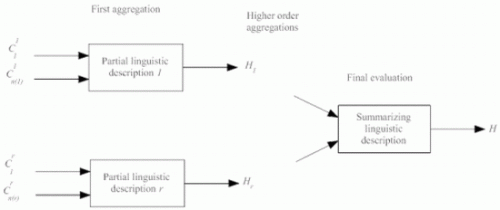The decision problem is usually decomposed into a hierarchy of linguistic descriptions which helps to deeper understanding to structure of the decision problem and reduces the number of variables (criteria) in the respective fuzzy IF-THEN rules.

Demonstration
Important decision characteristics
- Economical conditions of the company – they can be characterized using, e.g., gain over several years. Its trend can be estimated using fuzzy transform. Evaluation of the trend can be done using the following fuzzy IF-THEN rules: IF GainChange(t-3) is + Small AND GainChange(t-2) is + Medium AND GainChange(t-1) is + Big THEN Economical Conditions is +Very Big
- Economical characteristics of the new building that may consist of the following detailed characteristics: – Price, – Reconstruction costs, – Maintenance costs, – Taxes, etc.
- Technical characteristics of the new building – Total living area in square m, – No. of floors, etc.
- Aesthetical characteristics – Global appearance, – Stylishness, etc.
- Infrastructure characteristics (place, etc.)
Global evaluation of each building can be done using linguistic description consisting of fuzzy IF-THEN rules of the following form:
TechChar is + Roughly Big AND AestChar is + Very Big
THEN GlobEval is + More or less Big
Results of practical computation
Economical conditions of the company have been evaluated as Good (0.9)
|
Variant |
Global evaluation |
Economical characteristics |
Technical characteristics |
Aesthetical characteristics |
|
|
numerically |
verbally |
numerically |
numerically |
numerically |
|
| Building 1 | 0.49 | very roughly good | 0.53 | 0.47 | 0.77 |
| Building 2 |
0.54 |
very roughly good | 0.54 | 0.78 | 0.77 |
| Building 3 |
0.85 |
good | 0.9 | 0.78 | 0.77 |
| Building 4 |
0.92 |
significantly good | 0.9 | 0.78 | 0.93 |
On the basis of our computation we will choose Building 4 as the best fitting all our requirements.
[2] NOVÁK, V. Foundations of fuzzy modeling (Základy fuzzy modelování). Praha: BEN-technická literatura, 2000. 166 pp. ISBN 80-7300-009-1 (in Czech).
[3] NOVÁK, V., KOVÁŘ, J. Linguistic IF-THEN Rules in Large Scale Application of Fuzzy Control. In Fuzzy If-Then Rules in Computational Intelligence: Theory and Applications. Boston : Kluwer, 2000. ISBN 0-7923-7820-2. pp. 223-241.
